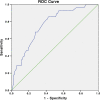Impact of anemia on in-stent restenosis after percutaneous coronary intervention
- PMID: 34798833
- PMCID: PMC8603472
- DOI: 10.1186/s12872-021-02355-1
Impact of anemia on in-stent restenosis after percutaneous coronary intervention
Abstract
Background: Anemia is a common risk factor for post-percutaneous coronary intervention (PCI) adverse events; however, data on its association with in-stent restenosis (ISR) is limited.
Methods: 538 patients who underwent PCI between January 2017 and September 2019 and follow-up angiography 9-12 months after the initial PCI were enrolled in this study. Baseline clinical and procedural characteristics were compared between the ISR and non-ISR groups, and independent predictors of ISR were determined using propensity score matching.
Results: The incidence of anemia was 53.5% in patients with ISR and 19.0% in those without ISR. Univariable logistic regression analyses showed that anemia (OR, 4.283; 95% CI, 1.949-9.410; P < 0.001), diabetes mellitus (OR, 2.588; 95% CI, 1.176-5.696; P = 0.018), chronic kidney disease (OR, 3.058; 95% CI, 1.289-7.252; P = 0.011), multiple stenting (OR, 2.592; 95% CI, 1.205-5.573; P = 0.015), bifurcation lesion (OR, 2.669; 95% CI, 1.236-5.763; P = 0.012), and calcification (OR, 3.529; 95% CI, 1.131-11.014; P = 0.030) were closely associated with ISR. Low-density lipoprotein cholesterol (LDL-c) levels and stent diameter were also significantly linked to ISR, as was anemia (P = 0.009) after propensity score matching.
Conclusion: Anemia is closely associated with post-PCI ISR, and patients with lower hemoglobin levels are at a higher risk of ISR.
Keywords: Anemia; In-stent restenosis; Percutaneous coronary intervention.
© 2021. The Author(s).
Conflict of interest statement
The authors declare no competing interests.
Figures
Similar articles
-
The characteristics and risk factors of in-stent restenosis in patients with percutaneous coronary intervention: what can we do.BMC Cardiovasc Disord. 2020 Dec 4;20(1):510. doi: 10.1186/s12872-020-01798-2. BMC Cardiovasc Disord. 2020. PMID: 33276720 Free PMC article.
-
Incidence and Influencing Factors of In-Stent Restenosis After Percutaneous Coronary Intervention in Patients With Coronary Artery Disease: A Systematic Review and Meta-Analysis.Catheter Cardiovasc Interv. 2025 Sep;106(3):1682-1699. doi: 10.1002/ccd.31711. Epub 2025 Jul 1. Catheter Cardiovasc Interv. 2025. PMID: 40598759 Review.
-
Remnant lipoproteins play an important role of in-stent restenosis in type 2 diabetes undergoing percutaneous coronary intervention: a single-centre observational cohort study.Cardiovasc Diabetol. 2019 Jan 28;18(1):11. doi: 10.1186/s12933-019-0819-z. Cardiovasc Diabetol. 2019. PMID: 30691501 Free PMC article.
-
Visit-to-visit HbA1c variability is associated with in-stent restenosis in patients with type 2 diabetes after percutaneous coronary intervention.Cardiovasc Diabetol. 2020 Sep 4;19(1):133. doi: 10.1186/s12933-020-01111-7. Cardiovasc Diabetol. 2020. PMID: 32887588 Free PMC article.
-
In-stent Restenosis.Interv Cardiol Clin. 2016 Apr;5(2):211-220. doi: 10.1016/j.iccl.2015.12.006. Epub 2016 Feb 13. Interv Cardiol Clin. 2016. PMID: 28582205 Review.
Cited by
-
Association between the long-term dialysis due to diabetic nephropathy and clinical outcomes in patients with coronary artery disease and chronic renal failure.Cardiovasc Interv Ther. 2025 Jul;40(3):506-515. doi: 10.1007/s12928-025-01109-6. Epub 2025 Feb 22. Cardiovasc Interv Ther. 2025. PMID: 39987417
-
Impact of Obstructive Sleep Apnea on In-Stent Restenosis in Coronary Heart Disease Patients after Elective Drug-Eluting Stenting.Rev Cardiovasc Med. 2025 Jan 15;26(1):25814. doi: 10.31083/RCM25814. eCollection 2025 Jan. Rev Cardiovasc Med. 2025. PMID: 39867172 Free PMC article.
-
Hemoglobin to red cell distribution width ratio as a prognostic marker for ischemic stroke after mechanical thrombectomy.Front Aging Neurosci. 2023 Nov 21;15:1259668. doi: 10.3389/fnagi.2023.1259668. eCollection 2023. Front Aging Neurosci. 2023. PMID: 38076531 Free PMC article.
-
Predictive Scoring Model for In-Stent Restenosis Risk in Coronary Artery Disease Patients.Med Sci Monit. 2025 Jun 11;31:e947986. doi: 10.12659/MSM.947986. Med Sci Monit. 2025. PMID: 40495366 Free PMC article.
-
Hemoglobin-to-Red Cell Distribution Width Ratio Was Associated with Cardiovascular Diseases and Death.J Clin Med. 2025 Jun 23;14(13):4464. doi: 10.3390/jcm14134464. J Clin Med. 2025. PMID: 40648838 Free PMC article.
References
-
- Gruntzig AR, Senning A, Siegenthaler WE. Nonoperative dilatation of coronary-artery stenosis: percutaneous transluminal coronary angioplasty. N Engl J Med. 1979;301(2):61–68. - PubMed
-
- Cassese S, Byrne RA, Tada T, Pinieck S, Joner M, Ibrahim T, King LA, Fusaro M, Laugwitz KL, Kastrati A. Incidence and predictors of restenosis after coronary stenting in 10 004 patients with surveillance angiography. Heart. 2014;100(2):153–159. - PubMed
-
- Tsai ML, Hsieh MJ, Chen CC, Chang SH, Wang CY, Chen DY, Yang CH, Yeh JK, Ho MY, Hsieh IC. Comparison of 9-month angiographic follow-up and long-term clinical outcomes of biodegradable polymer drug-eluting stents and second-generation durable polymer drug-eluting stents in patients undergoing single coronary artery stenting. Acta Cardiol Sin. 2020;36(2):97–104. - PMC - PubMed
-
- Jukema JW, Verschuren JJ, Ahmed TA, Quax PH. Restenosis after PCI. Part 1: pathophysiology and risk factors. Nat Rev Cardiol. 2011;9(1):53–62. - PubMed
-
- da Silveira AD, Ribeiro RA, Rossini AP, Stella SF, Ritta HA, Stein R, Polanczyk CA. Association of anemia with clinical outcomes in stable coronary artery disease. Coron Artery Dis. 2008;19(1):21–26. - PubMed
Publication types
MeSH terms
Substances
LinkOut - more resources
Full Text Sources
Medical
Miscellaneous


